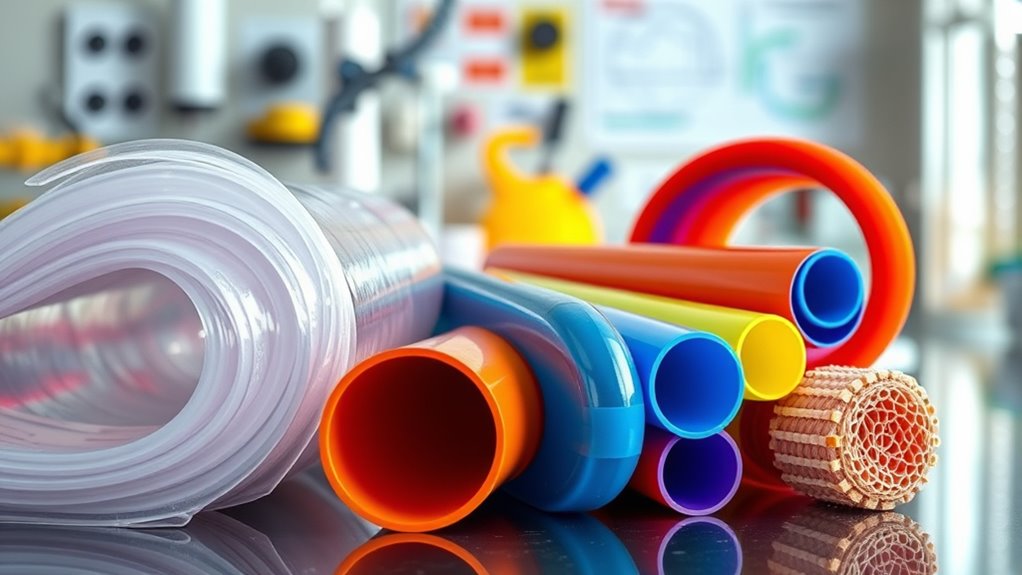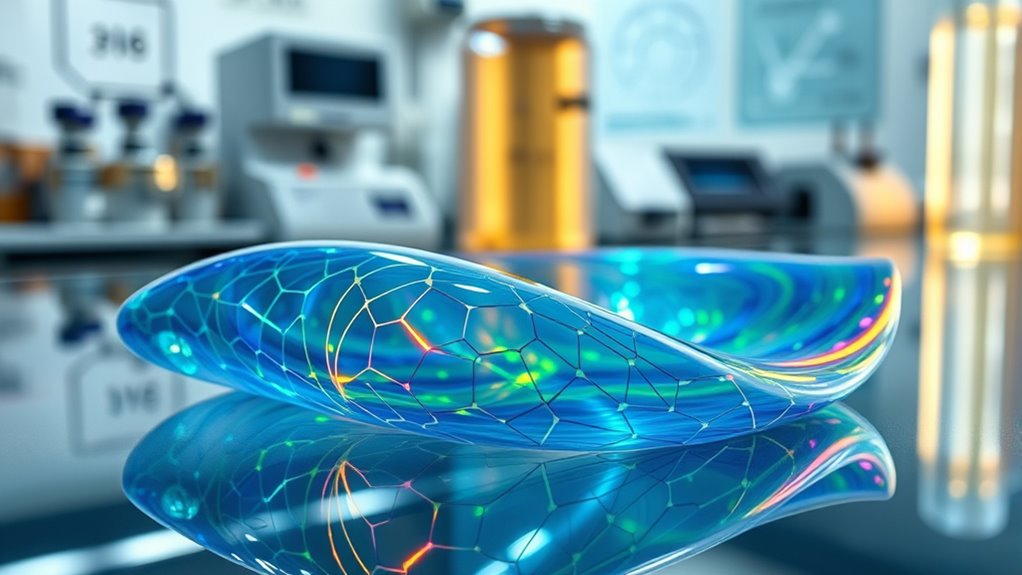Polymers are large molecules made from repeating building blocks called monomers, linked together through chemical bonds. They come in natural forms like proteins and cellulose, or synthetic types like nylon and polyester. Polymers are essential because they create products you use daily, such as clothing, packaging, and electronics, offering durability, flexibility, and lightweight properties. To understand how these versatile materials impact your life and industry, keep exploring their structure and innovations.
Key Takeaways
- Polymers are large molecules made of repeating monomer units linked by covalent bonds.
- They exhibit diverse structures, such as linear, branched, or crosslinked, affecting their properties.
- Polymers are essential in everyday products like clothing, packaging, vehicles, and medical devices.
- They provide lightweight, durable, and versatile materials suitable for various industrial and consumer uses.
- Advances in polymer science enable sustainable, recyclable, and high-performance materials for future applications.
Defining Polymers and Their Basic Structure

Polymers are large molecules composed of repeating subunits called monomers, which link together to form long chains. These monomers are simple molecules that connect through covalent bonds, creating extensive macromolecules that can contain hundreds to millions of units. The degree of polymerization determines the length and properties of the polymer chain. The backbone of a polymer mainly consists of carbon atoms bonded to other atoms like hydrogen, forming the main chain. Covalent bonds hold these atoms together, ensuring stability, while secondary forces such as van der Waals or hydrogen bonds organize multiple chains into a solid material. Polymers can be homopolymers, made from one type of monomer, or copolymers, composed of two or more different monomers. Their structure, whether linear, branched, or crosslinked, influences their physical properties and applications. Additionally, the flexibility and durability of polymers make them essential in a wide range of industries and everyday products.
Natural vs. Synthetic Polymers

Have you ever wondered where the materials around you come from? Natural polymers, like proteins and polysaccharides, are found in nature, extracted from plants and animals. They’re biodegradable, non-toxic, and easily compostable, making them environmentally friendly. Natural polymers are often water-based and can be obtained directly from their natural sources. These properties make them ideal for biomedical applications, such as wound dressings and tissue engineering. Synthetic polymers, such as nylon and polyester, are produced through chemical processes in labs and factories. They vary in biodegradability; some, like poly(lactic acid), are designed to be more sustainable. Many synthetic polymers are resistant to breakdown, contributing to pollution.
Both types are used in diverse fields—natural polymers in medicine and wound healing, synthetic ones in textiles and controlled drug release. The origin of these materials influences their properties, applications, and environmental impact, shaping how we use and manage them daily.
How Polymers Are Made: The Process of Polymerization

Understanding how polymers are made begins with the process of polymerization, a chemical reaction that links monomers into long chains. There are two main types: chain-reaction and step-reaction polymerization.
Polymerization links monomers into long chains through two main chemical processes.
In chain-reaction polymerization, initiation starts with free radicals from peroxides, which then add monomers in a propagation step, building the polymer chain. The process ends when radicals combine during termination. Common monomers include ethylene, activated by heat or light.
Step-reaction polymerization involves condensation reactions, where monomers gradually add together, often with catalysts, to form polymers like polyesters and polyamides. Factors like temperature, pressure, catalysts, and monomer concentration influence the reaction rate and polymer properties.
Both methods are essential for producing a wide range of plastic and synthetic materials used daily. Additionally, polymerization techniques significantly impact the physical and chemical properties of the resulting polymers, making them suitable for various applications.
Key Properties That Make Polymers Unique

The unique characteristics of polymers stem from their diverse physical, chemical, structural, and functional properties. Their low density makes them lightweight, ideal for aerospace and automotive uses.
Polymers also excel as thermal and electrical insulators, thanks to their low thermal conductivity and electrical conductivity. Their mechanical strength varies widely, allowing for flexible or rigid applications depending on their structure.
Chemically, polymers are influenced by intermolecular forces, side groups, and crystallinity, which affect their solubility and reactivity. Cybersecurity vulnerabilities can sometimes impact polymer manufacturing processes, highlighting the importance of secure digital systems in materials production.
Structurally, their molecular arrangement, chain length, and cross-linking shape their rigidity and flexibility.
Functionally, polymers can adhere to surfaces, self-assemble into complex forms, and sometimes conduct electricity.
These properties make polymers versatile, adaptable, and essential in countless industries.
Types of Polymers and Their Examples

Polymers can be classified into various types based on their monomer composition, reaction mechanisms, physical properties, backbone structure, and specialized functions. Homopolymers consist of a single monomer, like polyethylene, while copolymers contain multiple monomers, such as styrene-butadiene rubber. Terpolymers include three different monomers. Eye patches are a popular skincare product that uses polymers like hyaluronic acid to hydrate and smooth the skin. Natural polymers, like cellulose and proteins, are found in nature, whereas synthetic polymers, such as nylon and polyester, are man-made. Based on reaction mechanisms, addition polymers like polyethylene form through chain reactions, while condensation polymers like nylon develop via stepwise reactions. Physical property classifications include elastomers like rubber, thermoplastics like polypropylene, and thermosets like Bakelite. Understanding these types helps you recognize the diverse applications and properties of polymers in everyday life.
The Role of Monomers in Polymer Formation

Have you ever wondered how large, complex molecules like plastics and proteins are built? It all starts with monomers, which are small molecules that link together through chemical bonds. During polymerization, monomers combine to form long chains called polymers, with covalent bonds holding the units together. The specific types and arrangement of monomers directly influence the properties of the final polymer, such as strength, flexibility, and melting point. For example, amino acids form proteins, while glucose creates polysaccharides. Different polymerization methods, like addition or condensation, control how monomers join. The molecular structure of a polymer significantly impacts its physical and chemical properties. Your choice of monomers determines the characteristics and applications of the resulting polymer, making them essential building blocks for creating a diverse range of materials.
Why Polymers Are Essential in Daily Life

From medical devices to everyday packaging, polymers play a pivotal role in your daily routines. In healthcare, polymers are in contact lenses, implants, and wound dressings, improving treatment and patient comfort. They also help keep environments sterile with antimicrobial coatings and provide lightweight, durable gear for medical professionals. Additionally, the versatility of polymers allows for innovative material applications that enhance product performance and safety.
In food production, polymers extend shelf life by acting as moisture and oxygen barriers, used in packaging, cling films, and containers. They’re essential in clothing, offering fibers like nylon and polyester that are strong, flexible, and easy to care for, while providing water resistance and UV protection.
In transportation and construction, polymers reduce vehicle weight, improve insulation, and protect structures from damage. Overall, polymers enhance safety, convenience, and efficiency across many aspects of your everyday life.
Industries and Fields That Rely on Polymers

Many industries rely heavily on polymers to enhance performance, safety, and efficiency. In packaging, materials like polyethylene, polypropylene, and PET dominate because they’re durable, lightweight, and provide excellent barriers, reducing shipping costs and energy use. They also support recycling efforts, promoting sustainability.
In automotive and transportation, polymers such as polyurethane, polypropylene, and ABS help lower vehicle weight, improving fuel efficiency. Elastomers like synthetic rubber are essential for tires, while heat-resistant polymers protect electronics.
Healthcare depends on polymers like polyethylene, polypropylene, and silicone for medical devices, implants, and sterile packaging, ensuring safety and biocompatibility.
Electronics utilize polymers like polycarbonate and PVC for insulation and safety, while textiles rely on polyester, nylon, and spandex for durability and elasticity.
Polymers play a fundamental role across diverse industries, transforming everyday products and innovations.
Advances in Polymer Science and Research

Recent breakthroughs in polymer science are driving the development of smarter, more versatile materials. Advances in synthesis techniques, like organocatalytic polymerizations, enable precise control over polymer architecture, improving functionality. Meditation practices are increasingly integrated into research environments to enhance focus and creativity among scientists. Decarboxylative cobalt-mediated radical methods allow you to fine-tune polymer end groups, facilitating the creation of complex conjugates with peptides and nanomaterials. The emergence of multiblock copolymers enhances compatibility in blends and composites, expanding application possibilities. Researchers are also exploring linear and graft structures for custom properties. Fabrication innovations, such as improved processing methods, produce stronger, clearer, and more resistant polymers. Machine learning accelerates the design of novel electrolytes for batteries, while shape-shifting polymers offer safer biomedical devices. These advances are shaping the future of polymer development and expanding their practical uses.
The Future of Polymer Materials and Sustainability

The future of polymer materials hinges on sustainable innovations that address environmental challenges while meeting performance demands. Bio-based polymers from renewable resources like starch and cellulose reduce reliance on fossil fuels, offering eco-friendly options like polylactic acid (PLA). These biodegradable polymers can markedly cut pollution by naturally decomposing after use, and their adoption is rising in packaging, agriculture, and medical fields. Additionally, the development of specialized electric bike conversion kits demonstrates how polymer components are integral to lightweight, durable, and environmentally friendly transportation solutions.
However, challenges remain in matching the performance and cost-effectiveness of traditional plastics. Advanced recycling technologies, such as chemical recycling and improved sorting, enable polymers to be reused more efficiently, promoting a circular economy. Digital tools like IoT and AI optimize production, reduce waste, and enhance recycling.
Growing market demand and collaborations drive innovation, creating promising pathways for sustainable polymer development.
Frequently Asked Questions
How Do the Chemical Structures of Polymers Influence Their Physical Properties?
You see that a polymer’s chemical structure directly affects its physical properties. Longer chains increase strength and melting points.
While side groups like polar or hydrogen-bonding ones boost toughness and thermal stability. Straight, unbranched chains pack tightly for rigidity, whereas branching adds flexibility but reduces strength.
Cross-linking forms networks that resist deformation, and the degree of crystallinity influences stiffness and impact resistance. Your understanding of structure helps predict how a polymer behaves physically.
What Are the Environmental Impacts of Polymer Production and Disposal?
You should know that polymer production and disposal have significant environmental impacts. Energy-intensive manufacturing releases large amounts of greenhouse gases, contributing to climate change. Hazardous wastes and pollutants contaminate air, water, and soil, harming ecosystems and human health.
Additionally, polymers persist in the environment, breaking down into microplastics that threaten marine life and enter food chains. To reduce these effects, adopting sustainable practices and biodegradable alternatives is vital for protecting our planet.
How Can Polymers Be Recycled or Repurposed Effectively?
To recycle or repurpose polymers effectively, you need to understand different methods. Mechanical recycling involves sorting, grinding, washing, and reprocessing plastics for new use.
Chemical recycling breaks polymers down into monomers or chemicals, enabling reuse. Combining these approaches with innovations like solvent extraction and catalytic processes improves efficiency.
Overcoming economic and technological challenges is key, so stay informed about new techniques and support sustainable practices to maximize recycling success.
What Innovations Are Emerging in Biodegradable and Sustainable Polymers?
You’d think all these clever innovations would make plastics obsolete, but no, now we’re inventing biodegradable polymers that actually break down! Thanks to high-throughput methods and AI, you can find eco-friendly materials for electronics and packaging faster than ever.
Sustainable feedstocks like algae and biomass are replacing fossil fuels. These advances don’t just reduce waste—they transform manufacturing, making it smarter, greener, and more aligned with our planet’s future.
How Do Inorganic Polymers Differ From Organic Polymers in Applications?
You’ll find that inorganic polymers differ from organic ones mainly in their applications. Inorganic polymers excel in high-temperature environments, offering excellent heat resistance and electrical insulation, making them ideal for aerospace, electronics, and medical implants.
Organic polymers, on the other hand, are more versatile for everyday items like packaging and textiles due to their biodegradability and flexibility. Their distinct properties influence their specific uses across industries.
Conclusion
So, next time you marvel at your plastic gadgets or wonder why your rubber shoes last so long, remember—these everyday marvels are all thanks to polymers. Ironically, something so tiny and complex holds such power over your daily life, yet most of us barely think about it. Without polymers, our modern world would be unrecognizable. Isn’t it fascinating how these materials, often overlooked, keep everything running smoothly—until they don’t?









